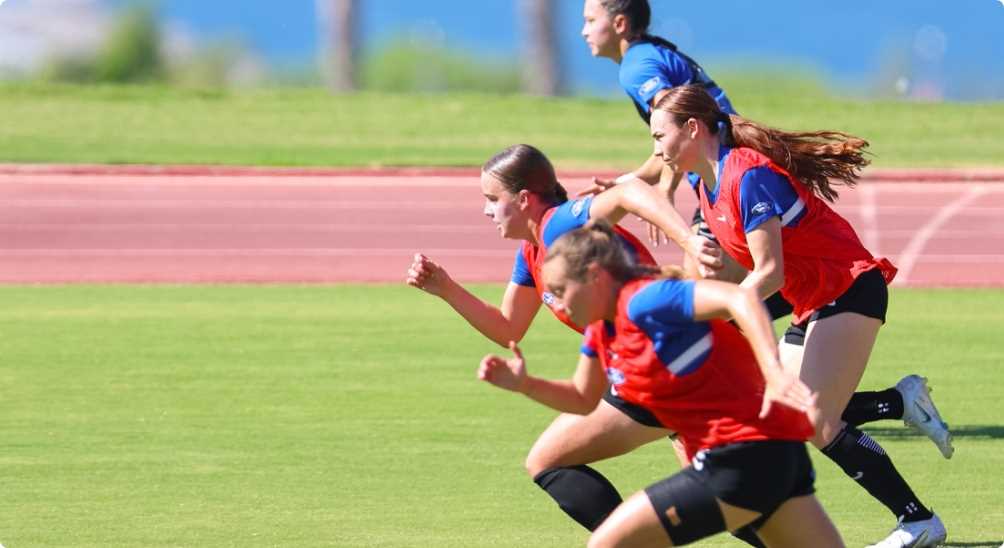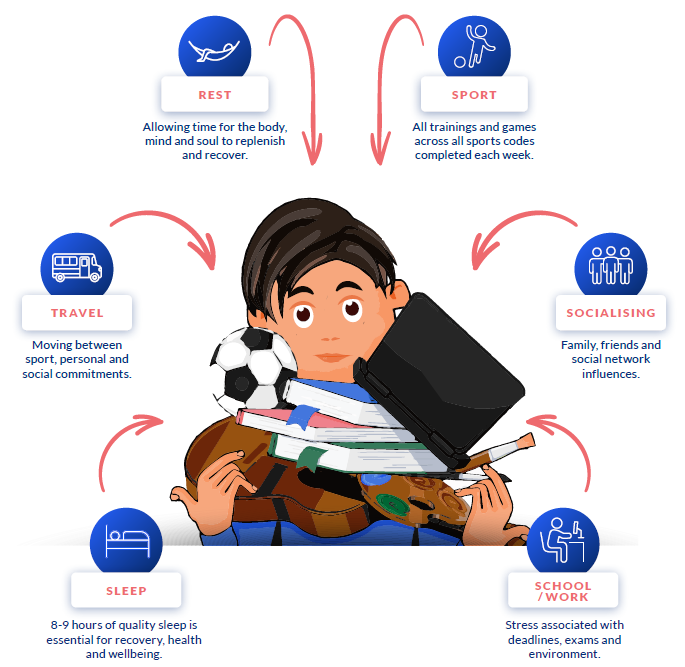
Parents & Caregivers
Ngā mātua me ngā kaitiaki
Advice, encouragement and support
How to best support your tamariki and rangatahi’s love for the game with simple, easy to understand resources and information that enhance your child’s footballing experience by reducing their risk of injury and providing the guidance you need to best support their development.

Female-specific tips
- Historically, many assumptions have been made that female players should prepare and perform the same as their male counterparts. This is incorrect!
- Within our female specific section, we unravel and delve into topics that are specific to the female player and how you can best support your child’s enjoyment and longevity within the game.
Did You Know – Females have an increase in iron requirements compared to their male counterparts. Low iron can result in fatigue, a decline in immunity and reduced resistance to illnesses.

Tamariki-specific tips
- To enhance the quality of our tamariki’s experience (aged 4-12 years), we need to embrace their passion for the game, improve their fundamental movements and playing skills; all while placing a priority on having fun.
- With today’s world of technology, we’re seeing more time spent on screens and less time running, hopping, skipping, jumping, climbing, or balancing.
Find out how you as a parent can improve the fundamental movements of your child with some fun games:

To ensure your child enjoys their footballing experience and to help you provide them with the opportunity to learn, thrive, and develop, keeping them on the field, we focus on 2 fundamental areas that severely reduce the risk of injury that will keep them involved in sport for life.
Warmups
The most effective and evidence-based activity to best prepare your child to perform on the field both mentally and physically whilst reducing the risk of injury.
What should be included in a good warmup?
- Low intensity running
- Dynamic stretching
- Change of direction movements
- Accelerating (speeding up)
- Decelerating (slowing down)
- Jumping and landing
- Sprinting
- Movements and actions that relate to the session/match
Top Warmup Tips
- Focus on technique! Make sure your landings are good, as well as proper alignment of the hips, ankles, and knees. The better the technique, the better and more efficient you move.
- Don’t start shooting at goal when you arrive! Your body is not physically ready for powerful and explosive movements such as shooting or long passing.
- If you’re a substitute on match day, ensure you have a warmup routine. If you want to make an impact on the game, you too need to be physically prepared.
- Ensure you have a warmup routine for substitutes during match day. To make an impact on the game, they too need to be physically prepared.
- If you want to sprint in the session/match, ensure you sprint in your warmup. 100% effort over 30 meters x 2 is a good place to start.
Warmup Videos
Check out our evidence-based GOLD standard warmups below that enhance performance and reduce the risk of all injuries by 30% and severe injury by up to 50%.
Strength & Conditioning
Providing you and your whanau practical examples to enhance the development of your child through fundamental movements and strength to reduce injury and move well.
What is Strength & Conditioning (S&C)?
Strength and conditioning is the practical application to enhance quality movement. However, we need to make this specific to the game of football and futsal to meet the demands of the game.
If we focus on movement quality and components relative to the game, we’ll improve performance with a specific focus on speed, strength, and stamina. This also helps prevent injury, keeping you in the game for longer.
Let’s look at what S&C looks like in football and why it’s important:
How can you improve these areas?
First, you need to identify where you’re at. What areas do you need to improve the most?
Rate yourself between 1 – 5 for each category and find out what you might do to enhance your physical capability.
Speed
Strength
Stamina
Second, once you’ve identified your area(s) of need, look to introduce some ‘add ons’ to your training sessions or perform them at home.
A few specific drills and exercises added to a training session will make a huge impact ensuring you progress with results without adding extra sessions to your schedule, which will ultimately enhance your performance.
Check out these simple yet effective drills that can added to training that will enhance your physical ability specific to football.
1. Improve Speed
Nordic
Nordic hamstring lowers are an effective and evidene-based exercise for increasing strength, sprint speed and guarding the hamstrings against injury.
Start with 3-5 repetitions and as you become stronger and more efficient, progress to 6-10 and then 10-15 repetitions.
Bounding
Plyometric exercises such as bounding help improve coordination and rhythm and is a powerful tool for improving speed from 5-20 meters, or mid-acceleration. It will also make you more powerful in explosive movements, such as changing directions and jumping off one leg.
Bound 2 x 20 meters (best completed post warm up or incorporated within your warmup)
Sprinting
Sprinting has many benefits but to become faster and more efficient at sprinting, you must sprint!
It's been shown that sprinting whilst not under fatigue, improves all 3 of our football components - muscle strength, stamina, and speed!
Sprint 2 x 30 meters post warm up (your sprints will be more effective post warm up and not under fatigue).

2. Improve Strength
Adding an element of strength work to training can be completed post warm up or at the end of training or at home.
Check out the following combinations that provide both core and leg strength which are 2 vital aspects in football performance.
C O M B I N A T I O N 1
C O M B I N A T I O N 2
3. Improve Stamina
Although Stamina is an important aspect of football, many of our players are getting enough stamina training by turning up to sessions and matches.
There may be a need to top up those players who are not playing every week, but this should be a small minority.
If you or your players are struggling with stamina, tiredness, or are lacking the ability to last a full game, you need to have a conversation with your coach/player. There are several reasons why a player maybe feeling tired with one of those aspects being overtraining/overload. Click here to find out more on managing load.
Top Stamina Tips
- Always ensure correct technique! Focus on alignment of the hips, knees, and ankles.
- Compliance and consistency are key. You should be performing strength and conditioning exercises 2 x week (minimum).
- Don’t go too hard too early and don’t compare your progress with others. You’ll receive better and faster results with great technique over going heavy or progressing to more advanced exercises too early.
- Ensure you control every movement throughout each exercise.
- Ensure you’re well warmed up prior to executing any S&C exercises and are not too fatigued.
- Set yourself a SMART goal. Do you want to get faster? Stronger? Setting an appropriate goal that’s Specific, Measurable, Achievable, Relevant and Time bound.
Did you know?
The average number of sprints made by players at the 2018 FIFA Men’s World Cup was 34 per match with the average max speed at 29.5 km per hour.
In the 2019 FIFA Women’s World Cup, teams that completed more sprints and at higher speeds were more likely to move onto the semi-finals.
Check out our evidence-based GOLD standard S&C exercise programme below that enhance performance and reduce the risk of all injuries by 30% and severe injury by up to 50%.
To find more useful information for parents, check out our list of parent resources.

The physical demands of our game, plus the social demands of life, schooling, social environment and any emotional strains, all interconnect and impact upon a player’s overall load and general wellbeing.
What is load?
Load is all the internal and external stress factors that are placed upon your body.
Load = The amount of stress placed on the player both internally and externally.
Stress = A state of physical, mental, or emotional strain or tension resulting from adverse or demanding circumstances.

So how do we monitor and manage a player’s load?
Monitoring players is essential to define the relationship between the amount of stress that’s been placed on the body, and the risk of injury.
Some simple examples could include:
- Tracking training and playing minutes.
- Measuring RPE at each session/match (Rate of perceived exertion)
- Recognising when school exams and work deadlines are coming up and comparing RPE at this time.
- Sleep (quality and duration).
- Tracking a daily mood score (amazing, good, meh, bad, awful).
Signs and symptoms of overtraining/overload:
- Persistent injuries and niggles
- Fatigue and tiredness
- Reduced appetite and weight loss
- Irritability and agitation
- Decline in performance
- Sessions and workouts constantly feel challenging
- Disturbed sleep
- Decreased immunity or illness
- Loss of motivation
Top Tips To Manage Load
- By tracking and keeping a log of these internal and external stressors, we can see how the player responds over time which allows us to adjust accordingly. As a coach, if you observe players are starting to feedback in your measures, or simply comment to you they’re starting to struggle, it is important you adapt.
- The ability to make informed decisions based on how a player feels, as well as plan how you are going to navigate periods of challenge ahead of time, is one of the most effective ways to reduce injury.
- It’s important we recognise that conversations around modifying training and the like can be difficult for players. One of the most effective ways you can create a dialogue with players, so they feel comfortable talking to you, is by starting it yourself. Reaching out to players, asking them about what they’ve got coming up at school, uni, work etc and letting them know what training looks like in the coming weeks can be invaluable.

See how the most common and debilitating injuries in football impact our game and what you can do to help your players return to play more effectively.
Ankle
Description
As football is a lower-extremity sport, the most common injury site in a football player is the ankle. The ankle is one common area that can sustain injury if we do not prioritise our preparation and recovery. Inadequate warm up preparation, inadequate training, fatigue (both acute and chronic), and poor recovery from previous injury are all factors that can contribute to injury that we can influence.
The most common type of ankle injury is a sprain, while more severe injuries such as fractures, ligament tears and cartilage damage can also occur. Striking a ball, changing direction, and landing while receiving body contact, are all common ways in which someone might injure their ankle.
Initial Steps
You can treat a minor ankle injury at home by following the P.O.L.I.C.E method.
For the first few days after your injury, Protect the injured area, ensure you provide Optimal Loading, Ice it, Compress it, and Elevate it.
If you suspect your injury is severe or if swelling and bruising persists, make an appointment with your doctor, physiotherapist, or go to the emergency department. The following symptoms may be a sign of a severe injury that requires professional care:
- severe swelling and pain
- visible deformities, such as large lumps or limbs bent at strange angles
- popping or crunching sounds when you move the injured area
- inability to support any weight with the injured area
- instability in a joint
- trouble breathing
- dizziness
- fever
You should also contact a medical professional if you have an injury that seems minor but doesn’t improve with home treatment.

Ankle Injury Prevention
Your first line of defence against ankle injury is an effective warm up. The gradual progression in intensity as well as exposure to wide variety of movements within a warmup gives your body the opportunity to perform movements in a controlled manner. Therefore, when we compete in football, which is more chaotic in nature, and we are reactive to opposition and the game, our body is prepared.
Further, proprioception exercises should be included in our warmup and can be done outside of the warmup to further reduce the risk of injury. Anything where we are jumping and landing, balancing on one leg, or challenging our single leg stability strengthens all the musculature in the lower leg as well as those which provide security to our ankle.
Knee (ACL)
Description
ACL - The anterior cruciate ligament helps to provide stability during movements of rapid changes of direction, pivoting, and landing. An injury to the ACL is most commonly non-contact (e.g., change in direction), although some ACL injuries can occur from contact (e.g., blow to the knee). A “pop” or “snap” sound is sometimes heard, but not always. Often, a player will experience pain and swelling to the area and will not be able to continue play.
Injuries to this ligament may result in the knee feeling loose or unstable. Surgical reconstruction followed by extensive rehabilitation is the traditional treatment. However, there is still the non-surgical option to treat the injury with rehabilitation, allowing other structures (muscular control and balance) to take over the job of the ACL.
Initial Steps
- Players should consult with a physician or sport physician to determine the severity of the knee injury. An MRI and other tests may be used to help diagnose the injury.
- Initially, the goal is to reduce swelling and control pain. Pain relief, such as anti-inflammatory drugs (NSAID), may be needed, in addition to ice.
- Players will undergo pre-operative exercises to prepare the knee and surrounding muscles for rehabilitation following surgery.
- Players who undergo non-operative treatment may work with a sport physician or physiotherapist and follow a rehabilitation protocol.
- Ongoing care and rehabilitation should be led and guided by your sport physician or physiotherapist before returning to training.
Statistics

- ACL injuries present a large cost to the healthcare system, more than $40 million per year in New Zealand.
- Female footballers are 8-9 times more likely to sustain an ACL injury
- It can take up to 9-12 months to return to the same level of play after an ACL tear
- Players that have ruptured their ACL are at a 30% higher risk to re-rupture their ACL for the remainder of their lifetime
Knee (ACL) Injury Prevention
Completing evidence-based warmups and exercise programmes can reduce the risk for ACL injuries by over 50%. Components of these training programmes may include:
- Correct technique for all prevention exercises is critical – coach feedback will improve the effectiveness of the programme
- Performing exercises a minimum of 2 x per week is essential to gaining results
- Starting in the off-season, continue through pre-season and continue throughout the year – Compliance and consistency is key!
- Monitor your health and wellbeing and ensure you’re not overtraining. Find out more here
Hamstring
Description
The “hamstrings” are a group of muscle located down the back of your thigh. They’re a major muscle group involved in multiple football actions; primarily - sprinting and running, jumping, and striking the ball. Not only are they involved in these key footballing movements, but they are major players, and their strength is essential in order to execute these actions well.
The most common cause of hamstring injury is when the muscle extends quickly or beyond its end range, resulting in damage to the muscle fibres of the hamstrings (often a tear.) Common examples when you may see a hamstring injury occur could be; during sprinting (as the athlete extends their leg out and forward), lunging for the ball (again, extending the leg out quickly), or when striking the ball (as the leg moves into end range at the end of the strike.) Often, we see this happen near the later stages of a game when muscles are fatigued or sometimes near the start/restart due to insufficient warming up of the hamstrings.
Initial Steps
You can treat a minor hamstring injury at home by following the P.O.L.I.C.E method.
For the first few days after your injury, Protect the injured area, ensure you provide Optimal Loading, Ice it, Compress it, and Elevate it.
If you suspect your injury is severe or if swelling and bruising persists, make an appointment with your doctor, physiotherapist, or go to the emergency department. The following symptoms may be a sign of a severe injury that requires professional care:
- severe swelling and pain
- visible deformities, such as large lumps
- popping or crunching sounds when you move the injured area
- inability to support any weight with the injured area
- instability in a joint
- trouble breathing
- dizziness
- fever
You should also contact a medical professional if you have an injury that seems minor but doesn’t improve with home treatment.

Hamstring Injury Prevention
We need to always ensure our body is ready to complete the physical demands of the game before we train or play. That is, we need to warm up! An effective warm up gradually increases in intensity and prepares the body for the movements it is about to complete. Our ‘Gold standard’ 11+ warmup is a scientifically validated example of a warmup that is effective in both preparation and injury prevention.
In addition to this, hamstring injury prevention should focus on ‘getting strong through extension’ as this is the common cause of injury as described above. We want to make sure that we can extend our hamstrings (sprint, jump, strike the ball) for the full 90 minutes with strength and quality. This will ensure that not only do we stay healthy and on the pitch, but key footballing actions will be performed with high quality.
The most common example of a hamstring strengthening exercise that works your muscles through full range is the Nordic Hamstring Curl. As you slowly lower, your hamstrings work to slow your fall. As you get lower to the ground, more and more fibres along the hamstrings are recruited to control this fall. Working to get stronger and fall further, or, working on the number of repetitions you can successfully fall all the way will help prepare your hamstrings for trainings and games!
Other exercises you can perform to minimise the risk of hamstring injury:
Concussion
Description
Sport-related concussion is a traumatic brain injury caused by a direct blow to the head, neck or body resulting in an impulsive force being transmitted to the brain that occurs in sports and exercise-related activities.
(Consensus statement on concussions in sport: The 6th International Conference on Concussion in Sport – Amsterdam, October 2022)
Concussion is a brain injury that affects the function of the brain and the person and may, or may not, result in a loss of consciousness. There are several important features to highlight including:
- A concussion is not always caused by a direct hit to the head. It may be caused by a direct hit to the head, face, neck, or elsewhere on the body with an ‘impulse’ force transmitted to the head.
- Only 10% of concussions present with a loss of consciousness.
- Concussions typically result in the rapid onset of short-lived impairment of neurological (brain cognition) function that resolves spontaneously.
Concussion and head injuries are everyone's responsibility. Coaches, players, clubs, and officials need to act in the best interest of player safety and welfare by taking responsibility for the RECOGNITION, REMOVAL & REFERRAL of all players with a suspected concussion or injury, to a medical professional (from a general practice or primary care team). They should then ensure that concussion is appropriately managed as per these guidelines.
Understanding Concussion Management:
View Poster - Understanding the R's
Graduated Return to Play Guideline:
View Poster - NZF Graduated Return to Play Guideline
View our Concussion Coach Player Development module on NZF Learn here - Concussion and Head Injuries
Statistics
- An estimated 35,000 head injuries occur in NZ per year
- 21% of all head injuries in NZ are sustained through sport.
- There is an estimated 1000+ related concussion injuries that go untreated.
- 11% of sports related concussion claimants had multiple concussions within a 2-year period.
- Evidence shows that with repeat concussion, people may experience a decline in general health and quality of life up to 10 years following injury.
Concussion Prevention
- Following the laws of the game will help keep players safe from most injury types. Avoid gameplay that puts you and others at risk.
- Physical conditioning (such as completing strength & conditioning exercises) will prepare your body for the physical demands of the game and increasing resilience to impact on the field.
- Players that return too early to training and competition after a concussion are more susceptible to sustaining another concussion. Follow the return to play guidelines and work with a medical professional to ensure player health and safety.
- Headgear – The use of headgear has not been shown to reduce the incidence of concussion. However, this piece of equipment can reduce soft tissue injuries to the head.
- Research suggests neck strength is thought to prevent concussions. Players with weaker necks are more likely to experience greater head impacts while players with stronger necks can withstand the velocity of a head impact diffusing the hit through the neck muscles. Speak to your physician or physiotherapist for some neck strength exercises.
FAQS
Have more questions? Take a look at our Frequently Asked Questions document here.
Top Tips For Parents
- Warming up is essential to reduce the risk of injury, enhance performance and improve fundamental movements. Ensure 13+ years complete the gold standard 11+ warmup and ages 4-12 complete the 11+ Kids warmup.
- Ensure your child is having a minimum of one full day’s rest per week. This allows for physical and mental recovery.
- Aim for 8-9 hours of quality sleep each night. Having adequate sleep assists in performance and recovery.
- Encourage other sports. Sporting diversification has been found to improve overall sport performance and decrease the risk of injury.
- Ensure your child has the appropriate gear for the surface they’re playing on.
- Remember the R.I.C.E.D principle and if an injury is more serious, seek medical advice. No player should play while in pain or carrying an injury.
- Have a snack ready for your child to consume immediately after training or a game (within 5-10 minutes). This will immediately kick start the recovery process.
- Understand what ‘load’ is and make the conscious decision to help your child understand what it is.
- Always remember: These are kids, this is a ‘game’, the coaches are volunteers, the referees are human, it’s not the world cup final.

 Admin Login
Admin Login